|
|
|
Sort Order |
|
|
|
Items / Page
|
|
|
|
|
|
|
| Srl | Item |
| 1 |
ID:
193093


|
|
|
|
|
| Summary/Abstract |
Right-wing terrorism (RWT) poses an increasing threat to Western societies, with perpetrators targeting diverse members of society. We investigated the affective and attitudinal outcomes of exposure to news about RWT, depending on the victims’ religious affiliation (Christian vs. Muslim). Results of a quota-based experiment in [Austria; predominantly non-Muslim] (N = 315) revealed no direct effects of the victims’ religious affiliation on affective and attitudinal outcomes. However, mediation analyses suggest that, compared to Muslim victims, Christian victims elicit higher perceived similarity, which in turn, impacts compassion. Similarity and compassion then significantly predict affective and attitudinal outcomes. Theoretical and practical implications are discussed.
|
|
|
|
|
|
|
|
|
|
|
|
|
|
|
|
| 2 |
ID:
193086
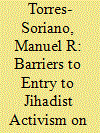

|
|
|
|
|
| Summary/Abstract |
The present article contends that terrorist activism on the Internet is determined by the technical configuration and ease of use of the tool. Engagement in Internet activities considered criminal offenses is not only explained by a progression in the level of radicalization of the individual. Rather, the type of barriers to entry which they must overcome plays a decisive role in the decision. The article classifies the various Internet spaces featuring terrorist content under the categories of “hard platforms” and “friendly platforms”. This differentiation will enable us to identify how the barriers to entry to such activism have evolved over the last two decades and how this evolution has been responsible for different levels of terrorist mobilization in cyberspace. The investigation focuses on jihadist terrorism and uses the antiterrorist operations carried out in Spain during the period 2001-2020 as a case study.
|
|
|
|
|
|
|
|
|
|
|
|
|
|
|
|
| 3 |
ID:
193095
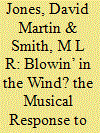

|
|
|
|
|
| Summary/Abstract |
Popular music was the most immediate way in which the cultural response to 9/11 manifested itself. Initially music offered a way of mourning and coping with grief. As the United States moved toward the invasion of Iraq, pop music also began to reflect the divisions in society between patriot-artists who supported the invasion, most notably in country music, and protest-artists who articulated critical attitudes to war. These anti-war songs did not attain the stature of those that characterized the era of protest during the Vietnam War, nor did they offer a musical accompaniment to a social movement with any enduring political significance. One little observed dissonance that a longitudinal survey of the musical response to political violence reveals, however, is that over time the attitudes of protest songwriters and the patriots transvalued. Ironically, interventionist “rednecks” became disillusioned with the endless wars of intervention, whilst the “protest” writers lost their voices after President Obama came to power. Ironically, icons of popular music instead turned their ire on those who voted for an anti-establishment President Trump who vowed not to involve the U.S. in further military adventures.
|
|
|
|
|
|
|
|
|
|
|
|
|
|
|
|
| 4 |
ID:
193090


|
|
|
|
|
| Summary/Abstract |
In the pursuit of security, state actors presume a linear relationship between the lethality and complexity of various means of attack. They deploy resources and research programs to overcome the inherent or “analytic” complexity of increasingly lethal means of their own (think of programs to develop nuclear weapons and other highly lethal munitions), and they impose security, legal and regulatory regimes to increase the imposed or “synthetic” complexity opponents must overcome to appropriate or adopt the means they develop. Nonstate actors such as terrorists overcome the challenges of complexity by imaginatively seeking new ways to operate in an alternative high lethality/low complexity space. The perversity of their imagination allows them to conceive of means of attack beyond the pale for state actors, leaving states initially unprepared to defend against them. Car bombs, vehicle ramming and small arms attacks on dense crowds, and iconic attacks such as 9/11 are examples of nonstate actors successfully operating in the high lethality/low complexity space. Successful attackers will continue to do so in ways that state actors fail to imagine and protect against, especially when the prevention of low-complexity attacks traditionally falls on local governments with fewer resources, and they employ means that do not have especially suspicious signatures. The deployment of weaponized drones against crowds and other soft targets may indicate one of the evolutions of this operational space. State security requires fully understanding the imagination of the nonstate actor, but good governance requires balancing the necessary thinking and preventive measures with the freedoms of a state not burdened by such a perverse outlook.
|
|
|
|
|
|
|
|
|
|
|
|
|
|
|
|
| 5 |
ID:
193099
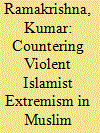

|
|
|
|
|
| Summary/Abstract |
This article argues that countering violent Islamist extremism in the southern Philippines requires greater employment of proactive Alternative Narratives (AN) rather than more reactive Counter-Narratives (CN). It offers the “4 M Way” of employing Alternative Narratives so as to achieve Information Dominance over countervailing violent extremist ideology. Properly executed, the 4 M Way could gradually steer vulnerable Muslims away from violent Islamist ideological rigidities toward the flexible beliefs that have long been part of the lived realities of Bangsamoro region—and essential for peace and stability in Muslim Mindanao.
|
|
|
|
|
|
|
|
|
|
|
|
|
|
|
|
| 6 |
ID:
193100
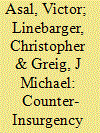

|
|
|
|
|
| Summary/Abstract |
International attacks by rebel groups are an historically important phenomenon. Yet, few scholars have sought to understand why some rebel organizations “go abroad” and commence international attacks and some do not. We theorize that a rebel group’s decision to attack internationally is partly the result of its home-state’s counter-insurgency strategy. Home-states that employ broad-based repression discourage rebels from engaging in international attacks. By contrast, home-states that employ narrowly targeted repression accelerate rebel decisions to attack internationally. Finally, concessions by the home-state are a sufficient condition for the rebel groups in our data to never attack internationally.
|
|
|
|
|
|
|
|
|
|
|
|
|
|
|
|
| 7 |
ID:
193087


|
|
|
|
|
| Summary/Abstract |
Extremists and the behaviors performed by extremists are a growing concern. There is a growing body of research showing the differences between violent and nonviolent extremists in terms of developmental pathways and actions. The current research used a temporal approach, crime script analysis, to map the pathways of violent and nonviolent extremists. Results showed differences between the groups in terms of Internet use, social networks and methods of enacting their beliefs. This research provides a new approach to understanding extremism and highlights the role of temporal methods in showing key differences that require different intervention strategies.
|
|
|
|
|
|
|
|
|
|
|
|
|
|
|
|
| 8 |
ID:
193069
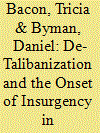

|
|
|
|
|
| Summary/Abstract |
This article examines the reasons for the rise of the Taliban and the onset of the insurgency in Afghanistan after the 2001 U.S. invasion, using counterfactual and path dependence analysis to bolster its arguments. We argue that the U.S. decision to de-Talibanize was a critical juncture, after which the rise of insurgency was far harder to prevent. The total rejection of the Taliban translated into the under-representation of Pashtuns in the Afghan government, delivering power to ethnic minorities at their expense. De-Talibanization led the United States to support strongmen to hunt the Taliban, but they were predatory, creating grievances that the Taliban exploited to recruit. Finally, de-Talibanization led many Taliban to flee to Pakistan, pushing them into the country most opposed to Afghanistan new political order. The lessons of the U.S. experience in Afghanistan suggest the necessity of a strategy for managing defeated enemies after an initial military victory.
|
|
|
|
|
|
|
|
|
|
|
|
|
|
|
|
| 9 |
ID:
193079
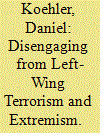

|
|
|
|
|
| Summary/Abstract |
Left-wing terrorism and extremism have received limited scholarly attention beyond a focus on large terrorist groups and violent campaigns between the 1970s and 1990s (e.g. German Red Army Faction, Italian Red Brigades, or Weather Underground in the United States). This article discusses the contribution of German research regarding disengagement from left-wing terrorism and extremism, as well as field experiences from Germany in the field of preventing and countering violent left-wing extremism. Significant research and prevention practice gaps severely limit knowledge in this regard. Available evidence mostly stems from highly structured and strategically operating groups from past decades.
|
|
|
|
|
|
|
|
|
|
|
|
|
|
|
|
| 10 |
ID:
193091


|
|
|
|
|
| Summary/Abstract |
This article examines the intersection of grievances, identity threats, and gender-based violence in the radicalization and attacks of post-9/11 lone actor terrorists in the United States. Before their attacks, many perpetrators committed acts of gender-based violence, and most experienced stressors related to the performance of hegemonic masculinity, a culturally constructed set of norms that places value on dominance and accomplishment. This study hypothesizes that these stressors might have been perceived as identity threats, catalyzing the attackers’ downward spiral toward violence. A thematic diagram relating stressors, male identity, and lone actor terrorism is offered as an alternative framework for understanding radicalization.
|
|
|
|
|
|
|
|
|
|
|
|
|
|
|
|
| 11 |
ID:
193068


|
|
|
|
|
| Summary/Abstract |
Everything that comes in, eventually goes out. One way or another. This paper will look into eating and defecating practices among rebels in Colombia, in particular, the FARC-EP. I will argue that these practices, despite being daily occurrences, have been overlooked in conflict studies. I will argue that eating practices in particular reinforced emotional bonds within the organization and fostered micro-solidarity. At the same time, eating and defecating practices reflected and reinforced, at once, organizational practices and ideological commitments of the rebels – particularly gender equality and collectivism. This paper, by focusing on cherished everyday activities which are deeply human, both biological and social, is a call to re-humanise this field of study.
|
|
|
|
|
|
|
|
|
|
|
|
|
|
|
|
| 12 |
ID:
193098


|
|
|
|
|
| Summary/Abstract |
Empirical data have indicated that radical Islamists often interpret their everyday life as embedded in religion. Nonetheless, the research field has at times tended to downplay the religious dimensions of radicalization processes. This paper aims to reinstate religion in analyses of radicalization by introducing the theoretical approach of everyday religion. By utilizing this approach, the paper argues that when religion, in the minds of radical Islamists themselves, has an effect on everyday lives and practices, then religion plays a substantial role in their radicalization process. The potential of the approach is illustrated through an analysis of interviews with former converts to radical Islamism.
|
|
|
|
|
|
|
|
|
|
|
|
|
|
|
|
| 13 |
ID:
193081


|
|
|
|
|
| Summary/Abstract |
Although many law enforcement and intelligence agencies are concerned about online communities known to facilitate violent right-wing extremism, little is empirically known about the presence of extremist ideologies, expressed grievances, or violent mobilization efforts that make up these spaces. In this study, we conducted a content analysis of a sample of postings from two of the most conspicuous right-wing extremist forums known for facilitating violent extremism, Iron March and Fascist Forge. We identified a number of noteworthy posting patterns within and across forums that may assist law enforcement and intelligence agencies in identifying credible threats online.
|
|
|
|
|
|
|
|
|
|
|
|
|
|
|
|
| 14 |
ID:
193084


|
|
|
|
|
| Summary/Abstract |
Despite the large number of foreign terrorist fighters from Russia in Syria and Iraq, the specifics of this phenomenon are often reduced to the Northern Caucasian connection. The article suggests a differentiated assessment of types and scale of threat posed by ISIS-linked FTFs in the Russian, Eurasian and broader international contexts, relying on data-based analysis of the main trends in the dynamic process of their circulation. They include changing composition of the FTF outflow, by type of domestic radicalization, low return rate, and high potential for relocation to third countries. The article challenges conventional views on correlation of threats posed by returnees and relocated FTFs, the main domestic challenge linked to Russian FTFs, the intra-Eurasian circulation of the FTFs, the risk of their concentration in northern Afghanistan, and potential for their cross-regional circulation between Eurasia, Middle East and Europe.
|
|
|
|
|
|
|
|
|
|
|
|
|
|
|
|
| 15 |
ID:
193077
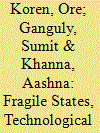

|
|
|
|
|
| Summary/Abstract |
Research on terrorism disagrees on whether terrorist activity is at its highest in collapsed states, which are more hospitable to such activities, or whether terrorism increases in more capable states. We revisit this discussion by theorizing an interactive relationship: terrorists prefer to operate in politically-hospitable states, but their attack frequency within these states increases with greater technological capacity, which allows them to expand their military, recruitment, and financing operations. We analyze 27,018 terrorist incidents using regression and causal inference models, conduct a case study, and find robust support for this interactive logic. Our conclusions outline implications for policy and academic work.
|
|
|
|
|
|
|
|
|
|
|
|
|
|
|
|
| 16 |
ID:
193080
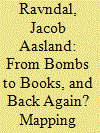

|
|
|
|
|
| Summary/Abstract |
This article begins by outlining four post-WWII strategies of right-wing revolutionary resistance: vanguardism; the cell system; leaderless resistance; and metapolitics. Next, the article argues that metapolitics became a preferred strategy for many right-wing revolutionaries during the 2000s and early 2010s, and proposes three conditions that may help explain this metapolitical turn: limited opportunities for armed resistance; a subcultural style shift; and new opportunities for promoting alternative worldviews online. Finally, the article theorizes about the types of threats that may emerge in the wake of this metapolitical turn, and speculates about the likelihood of a new and more violent turn in the near future.
|
|
|
|
|
|
|
|
|
|
|
|
|
|
|
|
| 17 |
ID:
193072


|
|
|
|
|
| Summary/Abstract |
The current study aims to assess the emotional processes that foster support for political violence. A survey of 1202 respondents was used to identify the association between emotional traits, support for extremist groups, and willingness to engage in political violence. Additionally, we tested how attitudinal traits’ interaction with emotional factors may impact radicalization. Our findings indicate that aspects of anger and anxiety, as well as emotional triggers related to social interactions, are associated with increased support for political violence and extremism. Moreover, we identified important pathways in which attitudinal and emotional traits interact to facilitate radicalization further.
|
|
|
|
|
|
|
|
|
|
|
|
|
|
|
|
| 18 |
ID:
193074


|
|
|
|
|
| Summary/Abstract |
This article advances the emergent literature on restraint within militant groups in three ways. First, it offers a framework for situating the “internal brakes on violent escalation”—understood as the practices through which group members shape the outer limits of their action repertoires—in relation to the interplay between conflict dynamics, intra-group processes and individual-level decision making. Second, it develops a basic analytical strategy for examining how such brakes operate at different levels of proximity to potential or actual instances of escalation. Third, it sets out four types of mechanisms through which internal brakes appear to generate or enable restraint.
|
|
|
|
|
|
|
|
|
|
|
|
|
|
|
|
| 19 |
ID:
193092


|
|
|
|
|
| Summary/Abstract |
Some moderation strategies of online content have targeted the individuals believed to be the most influential in the diffusion of such material, while others have focused on censorship of the content itself. Few approaches consider these two aspects simultaneously. The present study addresses this gap by showing how a socio-semantic network analysis can help identify individuals and subgroups who are strategically positioned in radical networks and whose comments encourage the use of violence. It also made it possible to identify the individuals and subgroups who act as intermediaries and whose statements are often the most violent.
|
|
|
|
|
|
|
|
|
|
|
|
|
|
|
|
| 20 |
ID:
193071


|
|
|
|
|
| Summary/Abstract |
Foreign fighters can be both an asset and a liability for the groups to which they are recruited. While they can bring with them much sought after skills and resources, they can also create tensions between foreign fighter contingents and local membership. This paper considers Al-Shabaab’s relationship with foreign fighters from the group’s foundational years in the 1990s through to the infamous purge of 2011–2013. By examining Al-Shabaab’s history and narratives around foreign-ness and foreign fighters, this paper finds that foreign fighters have persistently influenced Al-Shabaab’s organizational cohesion and structural integrity.
|
|
|
|
|
|
|
|
|
|
|
|
|
|
|
|
|
|
|
|
|